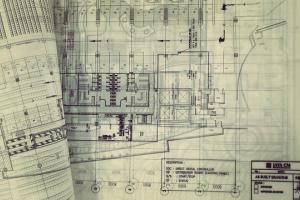Architectural Drawings Required for Building Construction

Architectural Drawings
- Setting Out Plan
- Floor Plans
- Elevation Drawings
- Section Drawings
- Working Drawings
- Opening Schedules
- Roof Drainage Plan
- Flooring Plan
- Furniture Plan
- Typical Details
Floor Plans
Floor Plans give a visual representation of a building. It shows a view from the above, of the relationships between rooms, spaces and other physical features at one level of a structure. For each floor unique plans are developed e.g.
- Ground Floor Plan
- First Floor Plan
- Second Floor Plan and so on.
The Ground Floor Plan shows structural (Beams, columns etc.) and architectural features (Openings, partitions etc.) of the building as well as shows the interior uses of a building. Circulation cores, including stairs and elevators, are required to be illustrated as well. These drawings may be viewed by both technical experts and the general public, so clarity and accuracy in proportion and scale are important. Dimensions may be shown as:
- Feet and percent of feet, otherwise known as decimal feet or
- Feet and inches. For example, a dimension may be either 5’ 3” or 5.25”.
Elevation Plans
Front Elevation
A front elevation is a part of a scenic design of the building as seen from the front. It is also required as a working drawing for engineering purposes and all measurements are written on it. It can also be used as a painting elevation but in that case it should have the exact colors and paint schemes to be used by the paint charge to paint the unit. The details include stairs, window designs, balconies, vents, doors, parapet wall or other architectural features (if applicable) which might not have been a part of structural drawings. It also includes the ground floor level height (GFL), first floor level (FFL), top floor level and parapet level and so on.
Left Elevation
It is the view of the building structure from its left side. It shows the building features which can best be viewed from the left side and helps the contracting staff in the field by providing relevant working details of the structure. It also includes all the detailing of the features as in the front elevation drawings, like GFL, FFL, opening specifications, cantilever portions of the building or other protruding features.
Right Side Elevation
Similarly, to provide more details about the other side of the structure, Right side elevation helps in showing the detailed specifications of the features occurring on the right side of the building structure.
Rear Elevation
The rear (back) view shows the building as viewed from the backside. It shows all the structural and architectural features which are visible from the rear view of the building. The details of the drawing are also the same as specified in the front elevation.
Section Drawings
Section at X-X
A section of the whole building is taken at two points in X-Direction which can show the structural and architectural features of the building that reside inside the building and are not visible from the outside. The section view contains information related to the type of material to be used in the building walls (cut by x-section line), location of openings like windows, doors, vents, ground level, Floor level, water proofing specification (e.g. bitumen coating specs, polythene sheet or other materials used), the mix ratio of mortar to be used, floor toping material, slab specification and other details as applicable.
Section at Y-Y
The section in Y-direction contains the same information as in the section at X-X drawing but only in the direction horizontally perpendicular to the X-X section line. It shows all the structural and architectural features of the building as viewed from inside when looking towards Y-Y line across the building.
Working Drawings
Floor Working Drawing
This plan shows the location of all the structural members like walls, beams, columns, stairs etc. on the ground floor. All the features and members are fully dimensioned and labelled as to what they represent on the ground. This also shows the location of X-X and Y-Y lines so as to enable the reader to understand where these sections have been taken. This will be the drawing which the contractor will use most often for working at the site so it must contain all the structural as well as necessary architectural features of the building.
Opening Schedule
Door and window schedule
Window and door schedule shows all the types of doors, windows and ventilators to be used in the building. All these openings are fully dimensioned and their architectural features are also shown, such as in the figure below.

Roof Drainage Plan
It shows the full system layout of all the drainage features on the roof top. Construction drawings shall clearly designate ridges and valleys and state relative falls. Flat roofs shall have a fall towards external gutters, outlets or roof edges of not less than 1:80 where there is no interruption in the flow of water, and 1:50 where there is an interruption in the flow. Where two directional falls intersect, the minimum finished fall of 1:80 shall be maintained along the miter. The required slope can be achieved on a concrete roof by casting or finishing concrete to the required fall, by applying sand-cement screeds to the concrete to achieve the required levels, or by a combination thereof.
Flooring Plan
This drawing shows the type of material to use for floors in different areas of the house on the ground floor e.g. tough tiles, patio, marble tiles etc. Different types of floors can be represented by different hatch patterns. Similar to the ground floor flooring plan, 1st floor drawing (2nd floor and so on) also show what materials to use for floors inside and outside of the house, in the rooms, washrooms, and kitchen as well as outside the house e.g. patios, terraces, lawns etc.
Furniture Plan
This is the optional drawing showing the location, style and setting of furniture items in the rooms, lobby, stores, washrooms, living rooms and all other areas of the building. You can include furniture items, TV sets, wash basins, sinks and stoves as and where required. This plan helps in giving a bird’s eye view to the client about how the setting will look like and decreases his confusions and misunderstandings.





